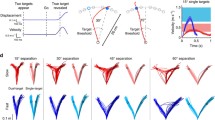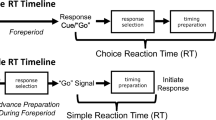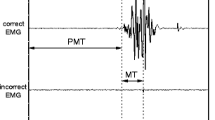Abstract
In a choice reaction time (RT) paradigm, providing partial advance information (a precue) about the upcoming response has been shown to decrease RT, presumably due to preprogramming of the precued parameters. When advance information about a particular aspect of a movement is provided (precued), several different strategies might be used to prepare the motor system during the foreperiod. For example, in studies where response preparation time was manipulated, precues were provided specifying the required arm and direction but movement amplitude was left uncertain. In this case it was shown that a default movement was preprogrammed whose amplitude was intermediate between the alternatives (Favilla et al. in Exp Brain Res 75(2):280–294, 1989, Exp Brain Res 79(3):530–538, 1990; Ghez et al. in Exp Brain Res 115(2):217–233, 1997). However, this strategy did not appear to be used in a RT task since there was an absence of online adjustments to movement. Therefore, it appeared movements were not initiated until all parameters had been correctly specified and programmed by the nervous system (Bock and Arnold in Exp Brain Res 90:(1):209–216, 1992). The present study reinvestigated the notion of a default movement preparation strategy in a choice RT paradigm, employing the triggering effect of a startling acoustic stimulus. On control trials (80 dB imperative stimulus), the movements were initiated toward the correct targets. Providing a startle stimulus (124 dB) resulted in the early initiation of a “default” movement whose amplitude fell in between the potential response alternatives. Thus, the current experiment found behavioral evidence of default intermediate-amplitude movement preparation as a strategy under conditions of response amplitude uncertainty.



Similar content being viewed by others
References
Bock O, Arnold K (1992) Motor control prior to movement onset: preparatory mechanisms for pointing at visual targets. Exp Brain Res 90(1):209–216. doi:10.1007/bf00229273
Carlsen AN, Chua R, Inglis JT, Sanderson DJ, Franks IM (2004a) Can prepared responses be stored subcortically? Exp Brain Res 159(3):301–309
Carlsen AN, Chua R, Inglis JT, Sanderson DJ, Franks IM (2004b) Prepared movements are elicited early by startle. J Mot Behav 36(3):253–264
Carlsen AN, Chua R, Summers JJ, Inglis JT, Sanderson DJ, Franks IM (2009) Precues enable multiple response preprogramming: evidence from startle. Psychophysiology 46(2):241–251. doi:10.1111/j.1469-8986.2008.00764.x
Carlsen AN, Maslovat D, Lam MY, Chua R, Franks IM (2011) Considerations for the use of a startling acoustic stimulus in studies of motor preparation in humans. Neurosci Biobehav Rev 35(3):366–376. doi:10.1016/j.neubiorev.2010.04.009
Carlsen AN, Maslovat D, Franks IM (in press) Preparation for voluntary movement in healthy and clinical populations: evidence from startle. Clin Neurophysiol
Elliott D, Carson RG, Goodman D, Chua R (1991) Discrete vs. continuous visual control of manual aiming. Hum Mov Sci 10(4):393–418. doi:10.1016/0167-9457(91)90013-n
Favilla M, Hening W, Ghez C (1989) Trajectory control in targeted force impulses. Exp Brain Res 75(2):280–294. doi:10.1007/bf00247934
Favilla M, Gordon J, Hening W, Ghez C (1990) Trajectory control in targeted force impulses. Exp Brain Res 79(3):530–538. doi:10.1007/bf00229322
Ghez C, Favilla M, Ghilardi MF, Gordon J, Bermejo R, Pullman S (1997) Discrete and continuous planning of hand movements and isometric force trajectories. Exp Brain Res 115(2):217–233. doi:10.1007/pl00005692
Goodman D, Kelso JS (1980) Are movements prepared in parts? Not under compatible (naturalized) conditions. J Exp Psychol Gen 109(4):475–495. doi:10.1037/0096-3445.109.4.475
Gottlieb GL, Corcos DM, Agarwal GC (1989) Strategies for the control of voluntary movements with one mechanical degree of freedom. Behav Brain Sci 12:189–250
Klapp ST (1996) Reaction time analysis of central motor control. In: Zelaznik HN (ed) Advances in motor learning and control. Human Kinetics, Champaign, pp 13–35
Kumru H, Urra X, Compta Y, Castellote JM, Turbau J, Valls-Solé J (2006) Excitability of subcortical motor circuits in Go/no Go and forced choice reaction time tasks. Neurosci Lett 406:66–70
Latash ML, Gottlieb GL (1991) An equilibrium-point model for fast, single-joint movement: similarity of single-joint isometric and isotonic descending commands. J Mot Behav 23(3):179–191
Maslovat D, Hodges NJ, Chua R, Franks IM (2011) Motor preparation and the effects of practice: evidence from startle. Behav Neurosci (Advance online publication). doi:10.1037/a0022567
Maslovat D, Hodges NJ, Chua R, Franks IM (in press) Motor preparation of spatially and temporally defined movements: evidence from startle. J Neurophysiol
Nijhuis LBO, Janssen L, Bloem BR, Van Dijk JG, Gielen SC, Borm GF, Overeem S (2007) Choice reaction times for human head rotations are shortened by startling acoustic stimuli, irrespective of stimulus direction. J Physiol 584(1):97–109. doi:10.1113/jphysiol.2007.136291
Reynolds RF, Day BL (2007) Fast visuomotor processing made faster by sound. J Physiol 583(3):1107–1115. doi:10.1113/jphysiol.2007.136192
Rosenbaum DA (1980) Human movement initiation: specification of arm, direction, and extent. J Exp Psychol Gen 109(4):444–474
Valls-Solé J, Rothwell JC, Goulart F, Cossu G, Muñoz E (1999) Patterned ballistic movements triggered by a startle in healthy humans. J Physiol 516(3):931–938. doi:10.1111/j.1469-7793.1999.0931u.x
Valls-Solé J, Kumru H, Kofler M (2008) Interaction between startle and voluntary reactions in humans. Exp Brain Res 187(4):497–507
Wadman WJ, Dernier van der Gon JJ, Geuze RH, Mol CR (1979) Control of fast goal-directed arm movements. J Hum Mov Stud 5:3–17
Acknowledgments
This study was supported by a grant from the Natural Sciences and Engineering Research Council of Canada (NSERC) awarded to I.M.F. and an NSERC Undergraduate Student Research Award (USRA) conferred to C.J.F. We would like to thank Dr. Digby Elliott and two anonymous reviewers for comments on an earlier draft of this manuscript.
Author information
Authors and Affiliations
Corresponding author
Rights and permissions
About this article
Cite this article
Forgaard, C.J., Maslovat, D., Carlsen, A.N. et al. Default motor preparation under conditions of response uncertainty. Exp Brain Res 215, 235–245 (2011). https://doi.org/10.1007/s00221-011-2893-7
Received:
Accepted:
Published:
Issue Date:
DOI: https://doi.org/10.1007/s00221-011-2893-7




